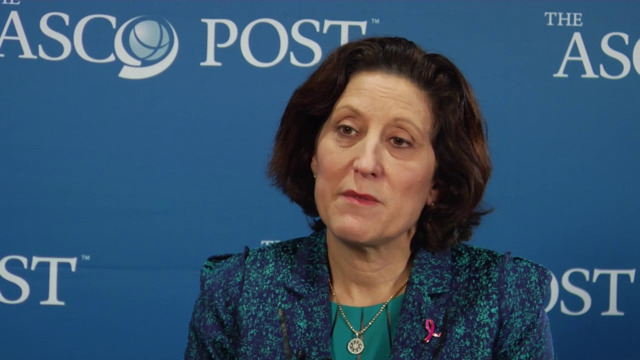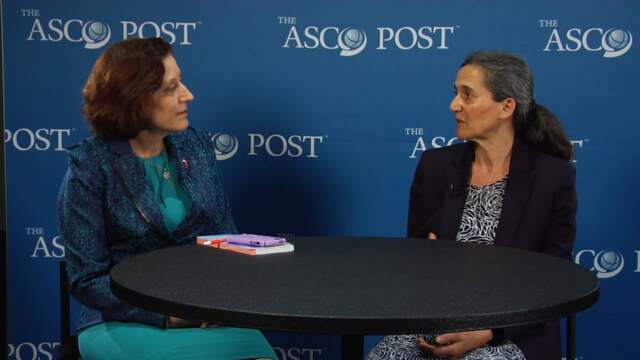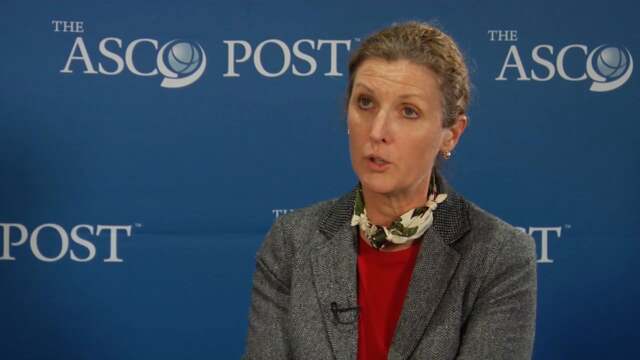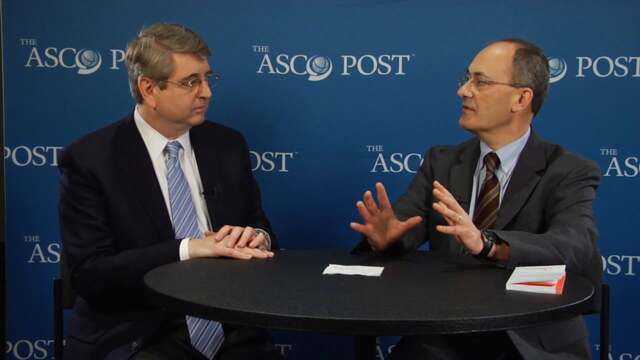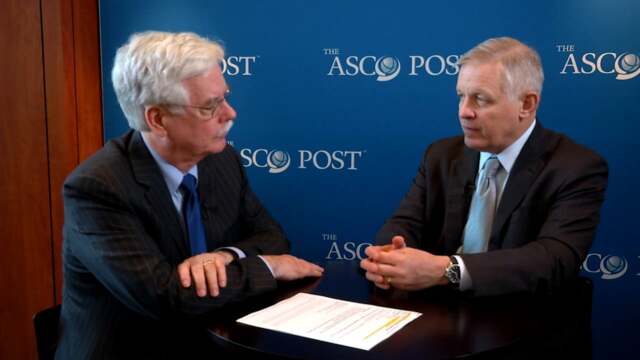2016 Quality Care Symposium: Study Suggests Many Women With Early Breast Cancer Receive Unnecessary Imaging Tests
A new study suggests that up to 60% of the computed tomography (CT) scans, bone scans, and positron-emission tomography (PET) scans performed for more than 29,000 Michigan women diagnosed with early breast cancer between 2008 and 2014 could not be medically justified based on retrospective record...
Phase III Trial Shows No Benefit of Afatinib vs Trastuzumab Plus Vinorelbine in HER2-Positive Metastatic Breast Cancer
In the phase III LUX-Breast 1 trial reported in The Lancet Oncology, Harbeck et al found no benefit of afatinib (Gilotrif)/vinorelbine vs trastuzumab (Herceptin)/vinorelbine after previous trastuzumab treatment in patients with HER2-positive metastatic breast cancer. Broader inhibition of ErbB...
ASCO Clinical Practice Guideline Update on Ovarian Suppression/Adjuvant Endocrine Therapy in Hormone Receptor–Positive Breast Cancer
As reported in the Journal of Clinical Oncology by Burstein et al, ASCO has released a clinical practice guideline update on ovarian suppression as part of the extant guideline on adjuvant endocrine therapy in hormone receptor–positive breast cancer. The update is based on an update panel...
FDA Approves Palbociclib in Combination With Fulvestrant in Hormone Receptor–Positive, HER2-Negative Advanced or Metastatic Breast Cancer
On February 19, 2016, the U.S. Food and Drug Administration approved palbociclib (Ibrance) in combination with fulvestrant for the treatment of women with hormone receptor–positive, human epidermal growth factor receptor 2 (HER2)–negative advanced or metastatic breast cancer with...
Men Get Breast Cancer Too
Like many men, it never occurred to me that I could get breast cancer. But it turns out it is more common—and deadly—than I thought, with about 2,600 men diagnosed each year with invasive breast cancer and nearly 440 dying of the disease.1 In 2010, I became one of those men, and the diagnosis was...
$13.4 Million Awarded to Study Treatment for Low-Grade Ductal Carcinoma in Situ in a Prospective, Randomized Trial
A funding award of $13.4 million hopes to answer one of the biggest questions in the current management of breast cancer: Do women with the earliest form of the disease, ductal carcinoma in situ (DCIS), need invasive surgery? Researchers at The University of Texas MD Anderson Cancer Center, Duke...
Study Finds Mechanism by Which Obesity Promotes Pancreatic and Breast Cancers
Massachusetts General Hospital (MGH) investigators may have uncovered a novel mechanism behind the ability of obesity to promote cancer progression. In their report published by Incio et al in Clinical Cancer Research, the research team describes finding an association between obesity and an...
Gene Previously Observed Only in Brain Is Important Driver of Metastatic Breast Cancer
When breast cancer becomes metastatic, patient survival is drastically reduced, prompting the need to explore the genes that may cause tumor cells to metastasize. Now, scientists from The Wistar Institute have shown that a gene that was once thought only to be found in the brain is also expressed...
ACS/ASCO Breast Cancer Survivorship Care Guideline
The American Cancer Society (ACS) and ASCO have issued a Breast Cancer Survivorship Care guideline, published jointly in the Journal of Clinical Oncology and CA: A Cancer Journal for Clinicians. The guideline recommendations were formulated by a multidisciplinary expert work group and are based on...
Looking at the Real-World Effects of Genetic Testing
According to the most recent estimates, 55% to 65% of women who inherit the BRCA1 mutation and about 45% of women who inherit the BRCA2 mutation will develop breast cancer by the time they are 70 years old. There is also a substantial increase in the probability of developing ovarian cancers in...
Superior Long-Term Outcomes Linked to Axillary Pathologic Complete Response After Chemotherapy for Breast Cancer
In an analysis of experience at MD Anderson Cancer Center reported in JAMA Oncology, Mougalian et al found that 10-year overall and relapse-free survival rates in patients with stage II or III breast cancer and axillary metastases receiving primary systemic chemotherapy were higher in those with vs ...
For Postmenopausal Women With Ductal Carcinoma in Situ: NSABP B-35 and IBIS-II DCIS Trials Offer a Choice of Endocrine Therapy
The past year has produced an embarrassment of riches regarding the value of aromatase inhibitors for women with ductal carcinoma in situ of the breast. The long-awaited NSABP B-35 study matured and was reported by Margolese and colleagues at the 2015 ASCO Annual Meeting this past summer, followed...
Comparing Recurrence Risk With Anastrozole vs Tamoxifen in Postmenopausal Women With Ductal Carcinoma in Situ
Two recently reported phase III trials compared adjuvant anastrozole vs tamoxifen in postmenopausal women with hormone receptor–positive ductal carcinoma in situ. As reported in The Lancet by Margolese et al,1 the National Surgical Adjuvant Breast and Bowel Project (NSABP) B-35 trial, performed in...
Neoadjuvant HER2 Inhibitor Therapy and Effect of Molecular Heterogeneity on Response in HER2-Positive Breast Cancer
In the phase III CALGB 40601 trial, reported in the Journal of Clinical Oncology by Lisa A. Carey, MD, of University of North Carolina at Chapel Hill, and colleagues, pathologic complete response rate was not significantly increased by adding neoadjuvant trastuzumab (Herceptin) plus lapatinib...
Tamoxifen or Anastrozole for Ductal Carcinoma in Situ?
Ductal carcinoma in situ is a relatively benign form of breast cancer (stage 0), yet up to 10% of women with ductal carcinoma in situ will have a recurrence within 10 years. At present, there is no way to identify which women will recur, so standard treatment is lumpectomy plus radiation therapy....
Synthetic 2D Mammography May Hold Advantages Over 2D/3D Mammography
In screening for breast cancer, results from a study in the United Kingdom suggest that the use of “synthetic” two-dimensional (2D) mammography, rather than 2D/three-dimensional (3D) combinations, could save radiologists’ time and patients’ exposure to radiation as well as result in many fewer...
Selected Abstracts From 2015 San Antonio Breast Cancer Symposium
The 2015 San Antonio Breast Cancer Symposium (SABCS), hosted by the American Association for Cancer Research, the Cancer Therapy & Research Center at The University of Texas Health Sciences Center at San Antonio, and Baylor College of Medicine, was held in December 2015. As has been true for...
High Pathologic Complete Response Rates Observed With Neoadjuvant Ado-Trastuzumab Emtansine
Neoadjuvant treatment with a chemotherapy-free, anti-HER2 regimen yielded high rates of pathologic complete response in patients with HER2-positive, hormone receptor-positive early breast cancer in the phase II WSG-ADAPT HER2+/HR+ (ADAPT) trial presented at the 2015 San Antonio Breast Cancer...
Higher Dietary Fiber Intake in Adolescence and Young Adulthood May Reduce Breast Cancer Risk
Women who eat more high-fiber foods during adolescence and young adulthood—especially fruits and vegetables—may have significantly lower breast cancer risk than those who eat less dietary fiber when young, according to a new large-scale study led by researchers at Harvard T.H. Chan...
Increased Breast Cancer Risk Reported in Childhood Sarcoma and Leukemia Survivors With No History of Chest Radiotherapy
In an analysis of the Childhood Cancer Survivor Study reported in the Journal of Clinical Oncology, Henderson et al found that childhood survivors of sarcoma and leukemia with no history of chest radiotherapy were at an increased risk of breast cancer. Increased Risk The study included data from...
Ian E. Krop, MD, PhD, on Pictilisib in Metastatic Breast Cancer
Ian E. Krop, MD, PhD, of Dana-Farber Cancer Institute, discusses abstract S2-02, “The FERGI phase II study of the PI3K inhibitor pictilisib (GDC-0941) plus fulvestrant vs fulvestrant plus placebo in patients with estrogen receptor–positive, aromatase inhibitor–resistant advanced or metastatic breast cancer: Part I results.”
Ann H. Partridge, MD, MPH, on Patient-Reported Outcomes From the SOFT Trial
Ann H. Partridge, MD, MPH, of Dana-Farber Cancer Institute, on abstract S3-09, “Patient-reported endocrine symptoms, sexual functioning and quality of life in the IBCSG SOFT trial: Adjuvant treatment with tamoxifen alone vs tamoxifen plus ovarian function suppression in premenopausal women with hormone receptor–positive early breast cancer.”
Hope S. Rugo, MD, on the Phase II FIRST Study
Hope S. Rugo, MD, of the University of California, San Francisco, discusses abstract S6-04, “Fulvestrant 500 mg vs anastrozole as first-line treatment for advanced breast cancer: Overall survival from the phase II FIRST study,” presented by John F.R. Robertson, MD.
Charles E. Geyer, Jr, MD, FACP, on the SOFT Trial
Charles E. Geyer, Jr, MD, FACP, of Massey Cancer Center, discusses abstract S3-08, “Randomized comparison of adjuvant tamoxifen plus ovarian function suppression vs tamoxifen in premenopausal women with hormone receptor–positive early breast cancer: Analysis of the SOFT trial,” presented by Prudence Francis, MD.
Harry D. Bear, MD, PhD, on the NSABP B-51/RTOG 1304 Trial
Harry D. Bear, MD, PhD, of Massey Cancer Center, discusses abstract OT1-3-02, “Will chest wall and regional nodal radiotherapy post mastectomy or the addition of regional nodal radiotherapy to breast radiotherapy post lumpectomy reduce the rate of invasive cancer events in patients with positive axillary nodes who convert to ypN0 after neoadjuvant chemotherapy? NSABP B-51/RTOG 1304 a phase III trial.”
Hope S. Rugo, MD, on Dietary Intervention as Adjuvant Breast Cancer Therapy
Hope S. Rugo, MD, of the University of California, San Francisco, discusses abstract S5-08, “Final survival analysis from the randomized Women's Intervention Nutrition Study (WINS) evaluating dietary intervention as adjuvant breast cancer therapy,” presented by Rowan T. Chlebowski, MD.
Harry D. Bear, MD, PhD, on the NSABP B-40 Study in HER2-Negative Breast Cancer
Harry D. Bear, MD, PhD, of Massey Cancer Center, discusses abstract PD2-1, “The effect on overall and disease-free survival by adding bevacizumab and/or antimetabolites to standard neoadjuvant chemotherapy: NSABP Protocol B-40.”
Clifford A. Hudis, MD, FACP, on the SOFT Trial
Clifford A. Hudis, MD, FACP, of Memorial Sloan Kettering Cancer Center, discusses findings from abstract S3-08, “Randomized comparison of adjuvant tamoxifen plus ovarian function suppression vs tamoxifen in premenopausal women with hormone receptor–positive early breast cancer: Analysis of the SOFT trial,” presented by Prudence Francis, MD.
Lisa A. Carey, MD, on the CALGB/Alliance 40603 Trial
Lisa A. Carey, MD, of the UNC Lineberger Comprehensive Cancer Center, addresses further analysis of data from abstract S4-05, “Impact of intrinsic subtype by PAM50 and other gene signatures on pathologic complete response rates in triple-negative breast cancer after neoadjuvant chemotherapy with or without carboplatin or bevacizumab: CALGB 40603/150709,” presented by William M. Sikov, MD.
Charles E. Geyer, Jr, MD, FACP, on the NSABP B-36 Trial
Charles E. Geyer, Jr, MD, FACP, of Massey Cancer Center, discusses findings from abstract S3-02, “NSABP B-36: A randomized phase III trial comparing six cycles of fluorouracil (5-FU), epirubicin, and cyclophosphamide (FEC) to four cycles of adriamycin and cyclophosphamide (AC) in patients with node-negative breast cancer.”
Edith A. Perez, MD, on Stromal Tumor-Infiltrating Lymphocytes in Early-Stage HER2-Positive Breast Cancer
Edith A. Perez, MD, of the Mayo Clinic Cancer Center, discusses abstract S1-06, “Stromal tumor-infiltrating lymphocytes: In the Alliance N9831 trial S-TILs are associated with chemotherapy benefit but not associated with trastuzumab benefit.”
Clifford A. Hudis, MD, FACP, on Enzalutamide in Androgen Receptor–Positive, Triple-Negative Breast Cancer
Clifford A. Hudis, MD, FACP, of Memorial Sloan Kettering Cancer Center, discusses findings from abstract P5-19-09, “Stage 1 results from MDV3100-11: A two-stage study of enzalutamide, an androgen receptor inhibitor, in advanced androgen receptor–positive triple-negative breast cancer,” presented by Tiffany A. Traina, MD.
Prudence Francis, MD, and Hope Rugo, MD, on the Phase III SOFT Trial
Prudence Francis, MD, of Peter MacCallum Cancer Centre, and Hope Rugo, MD, of the University of California, San Francisco, discuss data from abstract S3-08, "Randomized comparison of adjuvant tamoxifen plus ovarian function suppression vs tamoxifen in premenopausal women with hormone receptor–positive early breast cancer: Analysis of the SOFT trial."
Jame Abraham, MD, FACP, on Immunotherapy in Triple-Negative Breast Cancer
Jame Abraham, MD, FACP, of the Cleveland Clinic, offers his thoughts on abstract S1-09, "A phase Ib study of pembrolizumab (MK-3475) in patients with advanced triple-negative breast cancer," presented by Rita Nanda, MD.
Matthew J. Ellis, MD, on Endocrine Therapy–Resistant Breast Cancer
Matthew J. Ellis, MD, PhD, of the Baylor College of Medicine, offers a brief synopsis of his plenary lecture, "Genome-Directed Therapeutics for Endocrine Therapy–Resistant Estrogen Receptor–Positive Breast Cancer."
Gunter von Minckwitz, MD, on the Phase III ICE Trial
Gunter von Minckwitz, MD, of the University of Frankfurt, offers his thoughts on abstract S3-04, "The phase III ICE study: Adjuvant ibandronate with or without capecitabine in elderly patients with moderate or high risk early breast cancer."
Jack Cuzick, PhD, on the IBIS-I Trial
Jack Cuzick, PhD, of the Wolfson Institute of Preventive Medicine, discusses abstract S3-07, "16-year long-term follow-up of the IBIS-I breast cancer prevention trial."
William M. Sikov, MD, on the CALGB 40603 Trial
William M. Sikov, MD, of Women and Infants Hospital, discusses abstract S4-05, "Impact of intrinsic subtype by PAM50 and other gene signatures on pathologic complete response rates in triple-negative breast cancer after neoadjuvant chemotherapy with or without carboplatin or bevacizumab: CALGB 40603/150709 (Alliance)."
Lisa A. Carey, MD, on the TNT Trial
Lisa A. Carey, MD, of the UNC Lineberger Comprehensive Cancer Center, discusses abstract S3-01, “The TNT trial: A randomized phase III trial of carboplatin compared with docetaxel for patients with metastatic or recurrent locally advanced triple negative or BRCA1/2 breast cancer."
Lisa A. Carey, MD, on Pembrolizumab in Advanced Triple-Negative Breast Cancer
Lisa A. Carey, MD, of UNC Lineberger Comprehensive Cancer Center, offers her thoughts on abstract S1-09, "A phase IB study of pembrolizumab (MK-3475) in patients with advanced triple-negative breast cancer," presented by Rita Nanda, MD.
Harold J. Burstein, MD, PhD, and Lisa A. Carey, MD, on Innovations in Triple-Negative Breast Cancer
Harold J. Burstein, MD, PhD, of the Dana-Farber Cancer Institute and Lisa Carey, MD, of the UNC Lineberger Comprehensive Cancer Center, discuss: The TNT trial comparing docetaxel to carboplatin The CALGB trial on response rates after neoadjuvant chemo with or without carboplatin or bevacizumab Pembrolizumab in a phase Ib study
Lee S. Schwartzberg, MD, FACP, and Ian E. Krop, MD, PhD, on PI3K and PD-L1 Inhibition Data
Lee S. Schwartzberg, MD, FACP of The West Clinic and Ian E. Krop, MD, PhD, of the Dana-Farber Cancer Institute discuss the FERGI trial and data from phase I and phase II studies.
Ismail Jatoi, MD, PhD, FACS, and Clifford A. Hudis, MD, FACS, Discuss the SOFT Trial
Ismail Jatoi, MD, PhD, FACS, and Clifford A. Hudis, MD, FACS, discuss the role of ovarian suppression and hormonal therapy in premenopausal women.
Larry Wickerham, MD, and Harry D. Bear, MD, PhD, on NSABP Neoadjuvant Chemotherapy Trials
Larry Wickerham, MD, and Harry D. Bear, MD, PhD, discuss three clinical trials: • B-40, the only study to combine neoadjuvant and adjuvant chemotherapy with bevacizumab• B-51, on radiation to the chest wall• Alliance trial, on lymph node dissection
William J. Gradishar, MD, and Edith A. Perez, MD, on Immunotherapy and highlights of the Bolero-1 and SOFT Trials
William J. Gradishar, MD, of Northwestern University, and Edith A. Perez of the Mayo Clinic Cancer Center, discuss immunotherapy and the highlights of the BOLERO-1 and SOFT trials.
Matthew J. Ellis, MD, PhD, and Harold J. Burstein, MD, PhD, on Genome-Directed Therapeutics for Endocrine Therapy-Resistant ER-Positive Breast Cancer
Matthew J. Ellis, MD, PhD, of the Baylor College of Medicine discusses with Harold J. Burstein, MD, PhD, of the Dana-Farber Cancer Institute genome-directed therapeutics for endocrine therapy-resistant estrogen receptor-positive breast cancer.
Ismail Jatoi, MD, PhD, FACS, and Ann H. Partridge, MD, MPH, on the Movement Toward Bilateral Surgical Procedures
Ismail Jatoi, MD, PhD, FACS, of the University of Texas Health Science Center and Ann H. Partridge, MD, MPH, of the Dana-Farber Cancer Institute discuss the increasing movement away from breast conservation toward bilateral surgical procedures.
Larry Wickerham, MD, and Charles E. Geyer, Jr., MD, FACP, on Results from NSABP B-36 and SOFT Trials
Larry Wickerham, MD, and Charles E. Geyer, Jr., MD, FACP, take a closer look at the results from the NSABP B-36 and SOFT Trials.
Robert W. Carlson, MD, and William J. Gradishar, MD, on Optimizing Treatment of HER2-Positive Breast Cancer
Robert W. Carlson, MD, Chief Executive Officer, National Comprehensive Cancer Network, and William J. Gradishar, MD, Robert H. Lurie Comprehensive Cancer Center of Northwestern University, discuss the evolution of the breast cancer guidelines, the inclusion of varied fields––such as plastic surgery, pathology, patient advocacy, and radiation–– and new treatment changes.
Ingrid A. Mayer, MD, on New Therapies for Hormone-Sensitive Advanced Breast Cancer
Ingrid A. Mayer, MD, of the Vanderbilt-Ingram Cancer Center, discusses the evolution of endocrine therapy for metastatic breast cancer.


